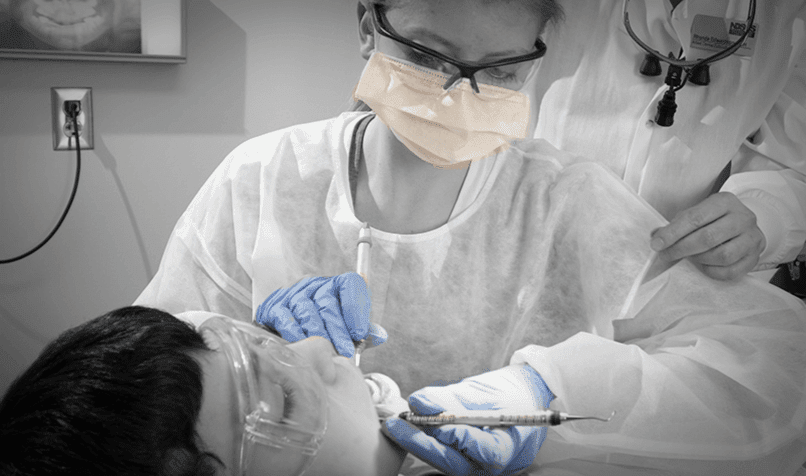There's an old saying "If the shoe fits, then wear it." It's got a ring to it, but it certainly wouldn't be good advice if we were talking about PPE use. The fact is when it comes to personal protective equipment (PPE), it's important to enforce minimum requirements to keep employees safe. In many cases this will be as simple as following manufacturers' recommendations, but in some cases it's up to the employer to set and enforce these minimum requirements.
The procedures you perform that require PPE to eliminate or reduce likely exposure to blood or OPIM are listed in your Exposure Control Section of your OSHA Manual. A requirement under the Bloodborne Pathogen Standard. PPE required for exposure to chemicals or other hazards will also be listed in your OSHA Manual. These tasks usually include lathe use and other rotary equipment, laser safety, scrubbing instruments and tasks that involve potential exposure to chemicals. These hazards usually fall under the Hazard Communication Standard or The General Duty Clause.
Going back to the original saying, "If the shoe fits, then wear it." There is one element that is 100% true. Size. PPE should be appropriate for each employees needs. That means sized correctly, but it should also address any personal needs, like a latex allergy.
Keep in mind, it's important to keep employees safe, but equally important to be realistic about minimum PPE requirements. In many cases gloves might be the only PPE that's required. Tasks like injections, cleaning treatment rooms or operatories and handling biomedical waste are usually listed as gloves only. Additional PPE might be available, but requiring it's use would be overkill and difficult to enforce in most situations. Example - Removing a red bag from an exam room can be done safely with gloves only. An employee could always exceed these minimum standards, but shouldn't be required to wear gloves, eye protection and a mask. Only list what's actually required, otherwise whatever is listed as minimum requirements would be expected to be enforced at all times. OSHA does not allow employees to sign waivers either, so enforcement must be consistent for all employees.
Examples.
- Scrubbing instruments - Possible risks include puncture with contaminated instrument, chemical exposure; skin, splatter. Utility Glove, mask, eye protection - Eliminating this task would actually be the best policy. Dirty instruments could be be placed in an ultrasonic prior to sterilization vs. manual cleaning by an employee.
- Lasers - Possible risks include eye damage and laser generated airborne contaminants (LGAC). Specialized Eye Protection / Glasses - Depending on the type of laser and it's use, it's best to defer to the manufacturers' recommendations for safe use. The addition of an engineering control, like an evacuation system could eliminate or reduce exposure to LGAC.
- High speed handpiece use - Possible risks include exposure to blood or OPIM. Gloves, Mask and Eye Protection, long sleeve barrier garments - OSHA considers saliva in dental procedures to be infectious. Because of the risk of aerosol; gloves, mask and eye protection must be worn. Long sleeve barrier garments must be available and depending on the specialty or practice may be enforced.
- Cleaning exam rooms, procedure rooms and operatories - Possible risk include exposure to bloodborne pathogens and possibly chemicals. Gloves - The biggest risk here is bloodborne pathogens. The disinfectant could be a potential hazard, but for the most part there are plenty of safe hospital grade surface disinfectants. The integrity of gloves can be effected by chemicals, so keep that in mind.
- Injections - Possible risks include exposure to bloodborne pathogens. Gloves - Technically gloves are only required when contact with blood or OPIM is anticipated. Gloves should always be worn for vascular procedures like Phlebotomy. Glove use is not required when blood is not anticipated; subcutaneous and IM injections. PPE should always be encouraged though and we have many facilities that mandate glove use regardless of the type of procedure.
None of the above situations are absolutes. It's important to assess your risk for the procedures and tasks you perform. PPE should be identified and employees should be trained on minimum requirements and safe work practices.
PPE needs to be provided and maintained at no cost to employees. It's important that it addressees any personal concerns and fits the employee appropriately.
Our 2020 OSHA Manual includes all your required policies as it pertains to a healthcare or dental facility. Common sense policies that includes everything that's required under the Bloodborne Pathogen Standard. Exposure determination, schedule of required PPE, Hepatitis B vaccinations, post-exposure prophylaxis and everything else you need to get your practice in OSHA compliance.

